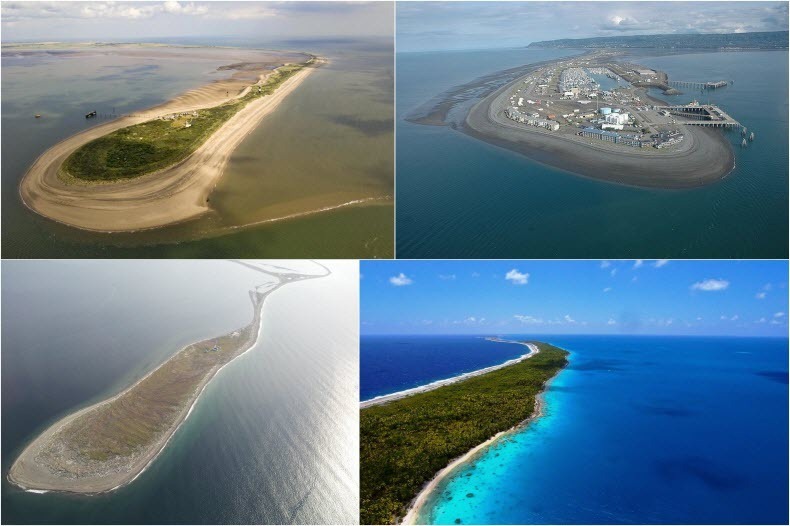In geography, spit is a landform made by the deposition of sand by the movement of tides. Spits are narrow and elongated – one end is attached to the mainland and the other is out in open water. A spit develops when waves meet the beach at an oblique angle, moving sediment down the beach and into the open waters where it is deposited in a narrow strip. As a spit grows, it might become stable and fertile and even support habitation. Here are some spectacular and scenic spits around the world.
Via - Amusing Planet
Via - Amusing Planet

Spurn Point
Spurn Point is one of the most striking feature of Britain's coastline – a narrow spit just 46 meters across, on the tip of the coast of the East Riding of Yorkshire, jutting out into the sea for five and a half kilometers across the Humber Estuary. On the tip is an enlarged head wherein lies a disused lighthouse and a lifeboat station.Spurn Head covers 280 acres and composed of sand and shingle banks held together by Marram grass and Seabuckthorn. Spurn is a relatively small place, yet an important wildlife haven for migrant birds, lizards, roe deer and numerous species of insects. Being open to the ravages of the North Sea, this narrow strip of land has a very delicate ecosystem. On one side, plants have learned to adapt themselves to being immersed in water every 12 hours, while on the other side, where the sand is moving around, you’ll find plants designed to retain moisture.
Spurn Point is a nice place for birdwatchers – there are even accommodation for overnight stay. On a good autumn morning one can see 15,000 birds fly past with 3,000 quite normal.

Photo credit

Photo credit

Photo credit

Photo credit
Farewell Spit
Farewell Spit is located at the northern end of the South Island of New Zealand, running eastwards from Cape Farewell, the island's northernmost point. It is the longest sandspit in New Zealand, stretching for about 26 km above sea level and another 6 km underwater. The spit runs in from west to east, and is made from fine golden sand – the spit is large enough to have its own sand dunes.
The northern side of the dunes are steeper and unstable being constantly exposed to the prevailing winds which average over 25 km/h. The southern side, that which faces Golden Bay is more stable and largely covered with vegetation. The tide here can recede as much as seven kilometers exposing some 80 square kilometers of mud flats - a rich feeding ground for the many thousands of sea birds in the area, but also a trap for the frequently stranded whales.
The Spit is administered by the New Zealand Department of Conservation as a sea bird and wild life reserve. Apart from a small area at the base of the Spit it is closed to the public except through organized tours. There is a lighthouse at the end of the spit which you can visit.

NASA satellite image of Farewell Spit.

Photo credit

Photo credit

Photo credit
Arabat Spit
The Arabat Spit in the Sea of Azov is the longest spit in the world at approximately 110 km in length. The spit is located between the town of Henichesk, Ukraine, on the north and the north-eastern shores of Crimea on the south, and separated from Henichesk by the Henichesk Strait. The Arabat Spit ranges from 270 meters to 8 km in width with a total surface area of 395 km2.The spit is very young and was created by sedimentation processes around 1100–1200 AD. It was wild until 1835 when a road and five stations spaced by 25–30 km were built along it for postal delivery. Later in the 19th century, 25 rural and 3 military settlements and one village named Arabat appeared on the spit. The rural population amounted to some 235 people whose occupation was mostly fishery, farming and salt production. The latter activity is traditional for the region due to the vast areas of shallow and very saline water in the Sivash lagoons. About 24,000 tonnes of salt were produced every year during the 9th century on the Arabat Spit alone.
Around the 17th century, the Turkish army built a fortress to guard the spit and Crimea from invasions. The Arabat Fortress still stands on the southernmost part of Arabat Spit.

Dungeness Spit
Dungeness Spit is 8.9 km long and juts out from the northern edge of the Olympic Peninsula in northeastern Clallam County, Washington, USA, into the Strait of Juan de Fuca. It encloses a body of water called Dungeness Bay. It is the longest natural sand spit in the United States.The Dungeness Spit is entirely within the Dungeness National Wildlife Refuge and home of the Dungeness Lighthouse. Visitors are allowed to hike all the way to the tip, where the lighthouse has been keeping guard since 1857. The extreme tip, however, like the Dungeness Bay side of the spit, is closed to public entry to protect important wildlife habitat. The refuge is a sanctuary for over 250 species of birds, 41 species of land mammals and eight species of water mammals.

Photo credit

No comments:
Post a Comment